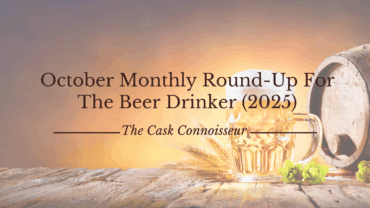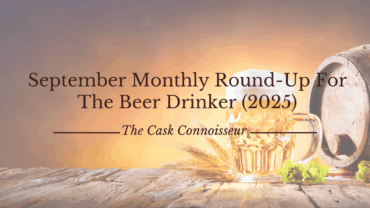Have you ever wondered what it’s like to have an expanding knowledge of a variety of different beers and whiskies, or have you ever thought how one day you could become a Cask Connoisseur just like me and have that understanding of how beer and whisky are brewed, plus how to detect flavour and aroma in both drinks?
Well, today is your lucky day! Throughout this post, I am going to bringing you all my latest advice and top tips on how you can become that all-important beer and whisky judge.
1. Learn Your Knowledge
Before you can even start thinking about sampling any beer or whisky, learning and studying your knowledge is a priority, I mean you wouldn’t want to be asked a beer-related question and not know the answer to it!
As soon as I turned 18, I developed my own personal interest in the brewing industry. My first step involved participating in a guided tour around The National Brewery’s Centre Beer Museum! This historical centre is located within my hometown in Burton Upon Trent.
The museum is designed to give you an understanding of how beer is made, specifically, how one tiny piece of barley can be turned into a succulent pint of beer, it’s not just that though, you’ll also learn how Burton Upon Trent became known as the brewing capital of the world!
I am so glad I decided to complete the guided tour of the museum because I believe without doing it, I would not have the knowledge and understanding of beer in today’s world.
Of course, you don’t have to participate in museum tours, you can also find some fascinating information on the Internet, there are many reliable sources available to view, still to this very day, I am always on the lookout for learning something new whether it’s to do with beer or whisky!
2. Travel Around
My next bit of advice is having the ability to travel to many areas of the UK so that you can expand your portfolio even more and learn where certain beers or whiskies are brewed/distilled. An example of this is Scotland, the majority of whisky connoisseurs will know that Scotland is the home of whisky.
Currently, I have only had the experience of visiting the local breweries in my town, but still, it’s brilliant to learn how many different breweries, brew their own beer in a specific way.
Whilst undertaking your own research of the area that you are visiting, you’ll probably find out why certain breweries have named their beers after a specific sculpture or architect, e.g. Sharp’s Brewery – Doom Bar amber ale that’s named after the perilous sandbank in Cornwall.
3. Build Your Palate
So far we’ve covered: Learning your knowledge and travelling around to complete your own research to understand the aspects of the brewing/whisky industry! Now it’s time to move onto the good stuff.
In order to have a palate like I do or any Connoisseur, you have to start small, firstly it’s always best to sample one thing at a time, for instance, don’t mix wine with cider or beer with lager, otherwise, your palate gets confused.
Okay, so your out and about and decided to sample a couple of beers, you can’t decide which one to try first, my advice is to start with the weakest beer first, make notes on what you can feel on the palate and then decide whether you enjoy the beer/whisky or not. Then, after finishing your first pint it’s vital that you clean your palate, water is the best thing for this, afterwards, you can try your next sample.
The more you clean your palate, the better your palate will have an understanding of the flavours that are involved in each glass. Furthermore, the more variety of alcoholic beverages you sample, obviously not in one go, the better your palate will improve over time.
4. Judging Your Beer/Whisky
Once your in the position that you can understand the different characteristics of many beers and whiskies, you’re now just a couple of steps away from becoming a cask connoisseur.
In reality, it’s alright knowing what the palate feels, but it’s equally important to be able to judge the beer in the correct format, for you have to follow the 4 step rule and I will admit I have mentioned this in a couple of blog posts recently, the rules are: Appearance, aroma, taste, after-taste.
Let’s now look over at these rules in more detail:
Appearance – This refers to the colour and clarity of the beer/whisky. Firstly, as a judge, you want to see if you’re going to be sampling a standard pale ale or something slightly malty, like a dark stout! After you’ve established the style and colour of the drink, it’s ultimately vital to check the clarity, meaning the clearness inside the glass, unless stated the liquid inside the glass should be clear, and there should be no signs of any off-smells, like vinegar!
Next, Aroma refers to the smell of the beer or whisky, this also delivers an idea of what hops have been used to create the beer, if it’s a citrusy style beer, Citra hops would’ve been used. In terms of whisky, it’s whether the whisky is sherried or malted.
The aroma also establishes a connection on what the taste of the drink could be, so in reference, if the beer/whisky smells sweet, more than likely the beer or whisky is going to be fruity.
Next, after taking notes on what the aroma is, it’s now time to sample your alcoholic drink, by taking just a small sip encourages the brain and palate to work together to determine what the flavour is, so what does the beer/whisky taste like, is it sweet, spicy, does the palate pick up chocolate or tropical fruits.
Remember to take notes, especially if you are judging with other connoisseurs, this helps to see if you all agree on what the drink actually tastes like, it’s perfectly normal to compare notes, and of course, there are no issues if you think something different, you have to remember everyone’s palate is different.
The final step to take into consideration is the after-taste, this step is required to work out what the flavours are after the sample has gone past the palate, flavours change quickly! You could be sampling something which is ultimately sweet at the start, but then 5 minutes later, the texture changes and becomes spicy, you sometimes get this in the whisky world!
Once you’ve fully completed these four steps, your well on the way to becoming a connoisseur, it’s easy really when you put your mind to it! The final tip is going to be the best bit of advice I can give you all and again it helps for you and others!
5. Teach Others
Okay, so you have now earned your reward of becoming a Cask Connoisseur, of course, you don’t have to do it this way, their many courses which can help, but in order to keep yourself up to date with the latest knowledge, it’s ideal that you support other people and teach someone who may want to be a Cask Connoisseur!
Like I said at the start of this post, I learnt my knowledge and history from the guided tour, but I’ve also been educated by some of the most amazing people who have worked in breweries, distilleries.
I believe it’s important to build relationships with the trading people, you’ll be able to find out more information on how a specific brewery operates, or how a certain whisky is distilled.
I’ve noticed over the past couple of years, how I’ve managed to help many people understand the importance of beer, plus how it should be poured and looked after! I’ve thoroughly enjoyed teaching my friends what I know, but I hope once all of you, my amazing followers have read this post, that you’ll understand how to become a Cask Connoisseur one day like me!
I thoroughly hope you’ve enjoyed this post, if you have any questions, or if you would like to find out more information on how I became a Cask Connoisseur, just post your thoughts in the comments below.
I wish you all a tremendous week!
Cheers





9Comments
June 15, 2021 at 12:59 pm
I find this process fascinating. I’ve never had a good palate, so feel like I wouldn’t be able to judge a beer or whiskey well. Did you find that your taste became a lot more sensitive as you tasted more? Did you have a good palate before starting out? I really respect this process and it’s really cool to hear about!
June 15, 2021 at 11:18 pm
When I first started drinking beer and whisky, my palate was just basic, I didn’t understand flavour, I couldn’t compare my palate with the tasting notes, but the more I started sampling, the better my palate improved. It takes time, not minutes, not days, but months of practice. 😁
June 15, 2021 at 9:14 pm
I love your top tips for what goes into becoming a cask connoisseur. It is amazing how educating oneself about something suddenly changes the way we set apart the casual experience from the enriched experience.
I also feel like this advice can apply diversely to people following their passions, which I love!
Thanks for sharing. 🙂
June 15, 2021 at 11:20 pm
Thank you so much Jaya, I mean anyone can do this, it’s just practice, like they say practice makes perfect, and the best thing I love about judging beer no one is wrong in what they can feel on each other’s palate.
June 16, 2021 at 12:07 pm
The way you’re able to taste the different flavours and can say how it was made etc, is just incredible! I have no idea how you do it, but as you said it takes time and you build up that skill. Very impressive and very interesting to learn how you went about becoming a cask connoisseur!
June 16, 2021 at 12:15 pm
Thank you, I do thoroughly enjoy having the swift palate to describe many different flavours. The more you practice the easier it gets 😁
June 16, 2021 at 3:51 pm
Great post! I would love the become a cask connoisseur, unfortunately I’ve developed terrible headaches post-drinking as I’ve gotten older. Do you have any recommendations for gluten free/low gluten beers and alcohols?
June 16, 2021 at 6:18 pm
Gluten free beers are so hard to come by, reason being many beers are made with malt and barely. However I can recommend, Old Speckled Hen Gluten Free or if you like ciders, Rekordelig, is also gluten free.
February 12, 2023 at 9:04 am